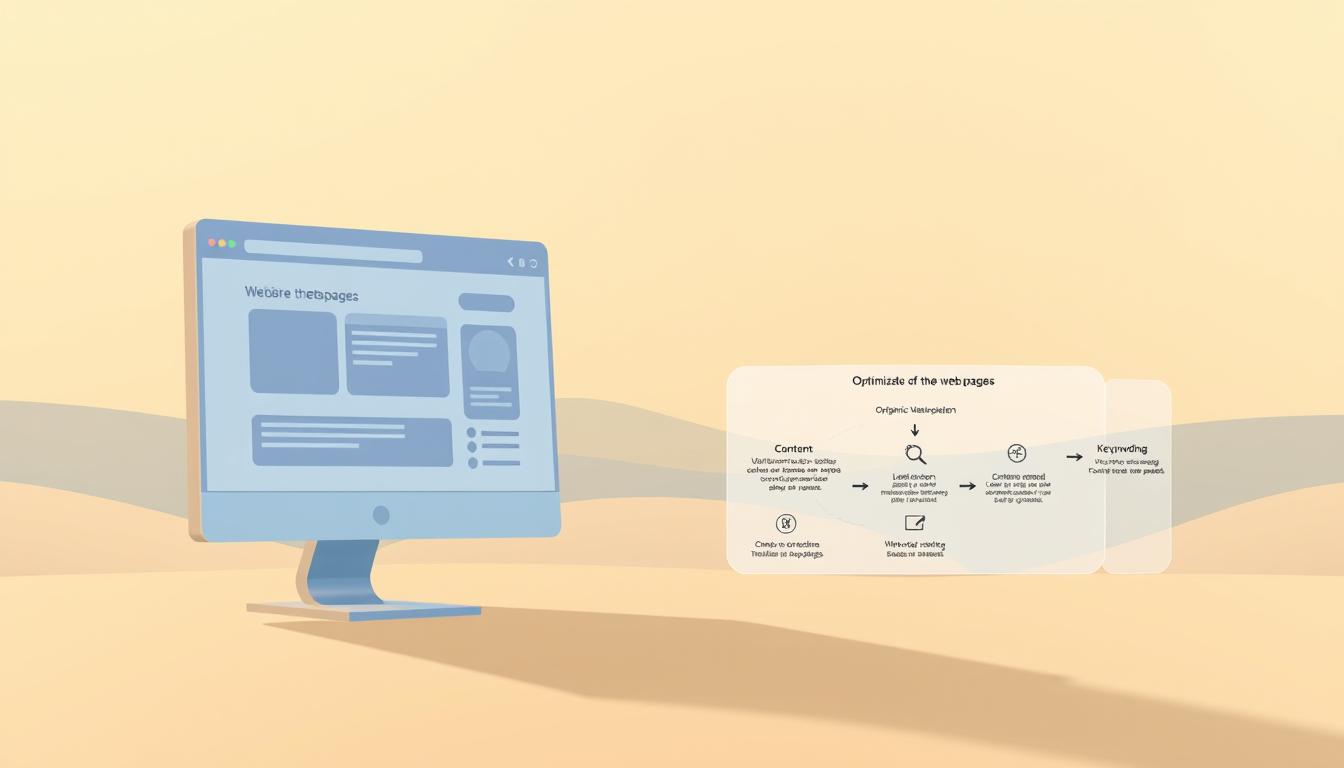Are underperforming pages holding back your website’s growth? Do you wonder why some content doesn’t connect with your audience or search engines?
Thin content syndrome is a common problem that hurts your site’s SEO. It’s about pages with low-quality or shallow content that don’t offer much value. Making these pages better is key to boosting your site’s organic rankings and attracting more visitors.

Studies show that focusing on content quality can greatly improve your organic rankings. For those dealing with thin content, getting help from experts like Zen9 Marketing can be a big help in their content improvement journey.
Key Takeaways
- Understanding the impact of thin content syndrome on SEO
- Identifying low-performing pages on your website
- Strategies for optimizing underperforming content
- The role of content quality in improving organic rankings
- How Zen9 Marketing can assist with content optimization
Understanding Thin Content Syndrome
It’s key to grasp thin content syndrome for top-notch SEO strategies. Thin content syndrome is when a site has low-quality, shallow, or unhelpful content. This content doesn’t add value to users.
What Qualifies as Thin Content
Thin content can be many things. It includes short articles with little depth, duplicate content, or pages full of ads. This type of content is a letdown for users and hurts search engine rankings.
The Impact of Thin Content on SEO Performance
Having thin content can drop your search engine rankings. Search engines like Google favor content that’s high-quality and user-focused. For tips on avoiding SEO mistakes, check out Link-Assistant’s guide on over-optimization signs.
Google’s Perspective on Content Quality
Google values content quality a lot. It wants content that’s informative, engaging, and meets user needs. Boosting content quality is vital for better SEO and a better user experience. Businesses can use AI to check and improve their content. This ensures it meets Google’s and users’ standards. For expert help in making your content better, reach out to Zen9 Marketing.
Why Thin Content Hurts Your Organic Rankings
Thin content can really hurt your website’s ranking. It makes the user experience worse and affects search engine rankings. For businesses trying to grow, knowing about thin content is key.
User Experience Signals
Thin content usually means a bad user experience. It doesn’t give users what they need. This leads to high bounce rates and low engagement. Optimizing content is vital for better user experience.
Search Engine Ranking Factors
Search engines like Google look for content that’s deep and valuable. Thin content, as WebFX defines it, lacks substance. By making content more in-depth, businesses can meet search engine standards.

Competitive Disadvantages
Websites with thin content struggle against those with rich content. Investing in content optimization can boost rankings and outdo competitors. For help in optimizing your content, consider Zen9 Marketing.
Identifying Low-Performing Pages on Your Website
Finding underperforming content is key to making your website better. Regular checks help spot areas that need work. This lets you use content optimization techniques to boost your site’s performance.
Using tools like Google Analytics is a must. Google Analytics shows how users interact with your site. It points out pages that don’t keep visitors interested or convert them.
Using Google Analytics to Spot Problem Areas
Google Analytics can find weak pages by looking at bounce rates, session length, and conversion rates. Pages with high bounce rates and short sessions might have thin or uninteresting content.
Search Console Insights for Content Performance
Google Search Console gives insights on how your pages do in search results. It shows impressions, clicks, and click-through rates (CTR). Pages with low CTR or impressions might need thin content SEO tips to get more attention.
Google says, “Content that’s informative, well-written, and detailed tends to rank higher.” This shows how important quality content is for SEO.
“The better your content is, the more likely it is to be shared and linked to, which in turn can improve your search engine rankings.”
Manual Content Auditing Techniques
Manual auditing means checking your content for relevance, accuracy, and detail. It helps find outdated info, missing content, or areas needing more or better content.
If you’re having trouble finding or improving weak pages, reaching out to experts like Zen9 Marketing can help. They can guide you in making your content better and boosting your organic rankings.
Looking at sales data and finding where your content fails is key. By knowing where your content is lacking, you can focus on making it better.
Diagnosing the Root Causes of Thin Content
Figuring out why content is thin means looking closely at how it’s made and the tech behind it. Thin content can really hurt a website’s ranking in search engines. So, finding and fixing the main problems is key.
Content Creation Shortcuts
Shortcuts in making content are a big reason for thin content. This includes copying content, using low-quality sources, or relying too much on automated tools without checking them. These actions not only make content thin but can also get you in trouble with search engines.
Technical SEO Issues
Technical problems can also make content thin. Issues like a bad website layout, crawl errors, or not enough internal links can stop search engines from indexing and ranking your content right. Making sure your website works well technically is vital for getting your content seen.
Resource Constraints
Not having enough money, time, or people can also lead to thin content. When resources are tight, making high-quality, interesting content is hard. Improving website content needs the right tools and resources.
To beat these challenges, think about using AI for making and improving content. AI can make creating content faster, better, and more effective. For companies with thin content, getting help from experts like Zen9 Marketing can offer custom solutions to boost rankings.
Here are some ways to tackle thin content:
- Make content creation better by avoiding shortcuts
- Fix technical SEO issues to help content get seen more
- Make sure you have enough resources for quality content

Fixing Thin Content: Step-by-Step Remediation Process
Fixing thin content needs a detailed plan. This plan should include expanding, improving, and engaging strategies. It’s key to know why the content is thin and to create a plan that fits.
Content Expansion Strategies
Expanding thin content is a big step. You need to do deep research to find more useful info. Content expansion makes the content longer and more detailed. This makes it more helpful for readers.
For example, if a blog post just gives a basic overview, you can add more. You could include case studies, expert opinions, or real-life examples. This makes the content more interesting and detailed.
Improving Content Depth and Expertise
It’s important to make your content more authoritative. You can do this by:
- Doing deep research on the topic.
- Adding data and statistics from trusted sources.
- Sharing expert opinions or quotes.
- Creating detailed guides or tutorials.
By making your content more detailed and expert, you improve its quality. This helps it do better in search engines. For more tips on using SEO in your content, check out Zen9 Marketing.
Enhancing User Engagement Elements
Keeping readers interested is key. You can do this with various elements:
Interactive Components
Things like quizzes, polls, and surveys can really get people involved. They make the content more fun and memorable.
Visual Enhancements
Adding images, infographics, and videos can make your content more appealing. Visuals help explain complex ideas and make text easier to read.
Here’s a look at different ways to make your content better:
| Strategy | Description | Impact on SEO |
|---|---|---|
| Content Expansion | Increasing content length and comprehensiveness | High |
| Improving Depth and Expertise | Enhancing content with research, data, and expert insights | High |
| Interactive Components | Adding quizzes, polls, and surveys to engage users | Medium |
| Visual Enhancements | Incorporating images, infographics, and videos | Medium |
If you’re having trouble with thin content, getting help is a good idea. Zen9 Marketing can help with content strategy and SEO. They can help make your content better.
Content Consolidation vs. Expansion: Strategic Decisions
Companies face a big choice: to consolidate or expand their content. This choice is key for better search rankings and a better user experience.
Before making a decision, it’s important to check your current content. Content consolidation means combining similar content into one, more detailed page.
When to Merge Similar Content
Merge similar content when:
- You have multiple pages targeting similar keywords.
- The content is fragmented, leading to a poor user experience.
- There’s an opportunity to create a more complete resource.
When to Expand Existing Pages
Expand existing pages when:
- The current content is thin or lacks depth.
- There’s more information or insights that can improve the page.
- User engagement can be better with more detailed content.
Content Pruning Best Practices
Content pruning means getting rid of content that doesn’t work well. Best practices include:
- Identifying and eliminating duplicate or irrelevant content.
- Updating outdated information to keep content fresh.
- Redirecting traffic from deleted pages to relevant, existing content.
For businesses having trouble with content optimization, getting help is a good idea. Companies like Zen9 Marketing can help with content strategy and optimization. They guide businesses in making the right choices about content.
Advanced Content Optimization Techniques
There’s more to optimizing content than the basics. As search engines get smarter, we need better strategies. Fixing Thin Content and Improving content quality are key steps.
Semantic SEO for Content Enrichment
Semantic SEO makes content more than just keyword-filled. It’s about making it meaningful and relevant. This way, search engines get what your content is about, making it more visible.
By adding related entities and concepts, your content becomes richer. It serves users better, meeting their needs.
Entity Optimization Strategies
Entity optimization links your content to known entities. This means using names, locations, and concepts search engines recognize. It boosts your content’s credibility and authority.
Entity-based optimization helps your content rank better. It’s a smart way to get noticed by search engines.

Content Structuring for Featured Snippets
Creating content that answers questions or gives quick info can get it featured in Google snippets. Use clear headings and concise paragraphs. Adding structured data helps too.
Optimizing for featured snippets can make your content more visible. It attracts more clicks, helping your site get more traffic.
For businesses wanting better content performance, advanced SEO is essential. Working with experts like Zen9 Marketing can help. They offer the insights and strategies needed to optimize content well.
By using these advanced techniques, businesses can boost their content’s visibility and ranking. This drives more organic traffic to their sites.
Essential Tools for Content Quality Assessment
Evaluating content quality is key. It needs special tools and methods. To boost your SEO, you must check your content’s performance well.
Content Analysis Software
Many tools can analyze your content’s quality. SEMrush and Ahrefs are top picks. They give insights on keywords, backlinks, and content gaps.
For example, SEMrush’s Content Analyzer tool checks content on many levels. It looks at readability, tone, and originality.
Readability and Engagement Metrics
Readability and engagement metrics are important. They show how your audience interacts with your content. Tools like Hemingway Editor and Grammarly check readability. They suggest ways to make your writing better.
- Hemingway Editor makes your writing easier to read by pointing out complex sentences.
- Grammarly gives detailed feedback on grammar, tone, and style.
Competitor Content Benchmarking Tools
It’s important to see how your content compares to others. Tools like Moz and BuzzSumo let you compare your content to industry leaders.
| Tool | Function | Key Features |
|---|---|---|
| SEMrush | Content Analysis | Keyword performance, content gaps |
| Hemingway Editor | Readability Assessment | Sentence complexity, readability score |
| Moz | Competitor Benchmarking | Content performance, keyword analysis |
For expert help in making your content better, reach out to Zen9 Marketing. Their team offers custom strategies to improve your content’s performance.
Measuring Success: KPIs for Content Improvement
To see if your content is working, you need to watch key performance indicators (KPIs) closely. This way, you can tell if your efforts to make your website better and fix thin content SEO tips are paying off.
Watching the right KPIs shows how your content changes are doing. You track different metrics to see how well your content is doing.
Traffic and Engagement Metrics
How much traffic your content gets is a big sign of success. Page views, unique visitors, and average session duration are key. They show if your content is keeping people interested.
Looking at bounce rates and exit rates can also help. These show if your content is relevant and easy to use.
Conversion Rate Improvements
Content success is often about getting people to do something. Form submissions, purchases, or newsletter sign-ups are examples. Tracking these shows if your content is helping your business goals.
To get more people to act, your content needs to be interesting and match what users want.
Search Ranking Position Changes
Changes in search rankings are a big sign of how well your content is doing. Tracking keyword positions shows if your SEO work is paying off.
Short-term Indicators
Short-term, look at click-through rates (CTR) and keyword ranking improvements. These signs show if your content plans are working.
Long-term Performance Trends
For a full picture, look at long-term trends. Watch for steady growth in organic traffic, user engagement, and conversion rates over time.
For more on tracking content performance, check out 50 Metrics to Measure Your Content Marketing. It helps find the best KPIs for your strategy.
If you’re having trouble with your content or need help, reach out to experts like Zen9 Marketing. They can help make your website better and improve your SEO.
Conclusion: Building a Sustainable Content Strategy
A sustainable content strategy is key for success in today’s digital world. Fixing thin content is a big step towards this goal. It helps businesses make their content better, improve user experience, and rank higher in search engines.
By using the strategies from this article, businesses can build a strong content plan. This plan helps them get more organic traffic and keep people engaged. For help in making your content better and reaching your online goals, check out Zen9 Marketing. They are experts in content marketing and SEO.
By focusing on fixing thin content and planning ahead, businesses can grow online. They can connect better with their audience and achieve long-term success.
Frequently Asked Questions
What is thin content, and how does it affect my website’s SEO?
How can I identify low-performing pages on my website?
What are the common causes of thin content, and how can I address them?
What is the difference between content consolidation and expansion, and when should I use each approach?
How can I measure the success of my content optimization efforts?
What are some advanced content optimization techniques I can use to improve my content’s visibility?
How can I assess the quality of my content, and what tools can I use for this purpose?




